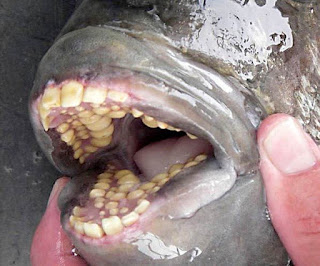9 MOST DANGEROUS SMALL FISHES IN THE WORLD
16:13 |
| Box Fish |
9: Boxfish(Ostracion cubicus):They have a chemical defense system. This consists of a potent toxin, known as ostracitoxin, which they exude in their slime when they are stressed. The toxins are chemically unlike any other known fish toxin, and the toxins are used in an entirely different way, they don't sting or need to be touched or eaten to be toxic.
Although these toxins
appears to have evolved to specifically combat gilled predators like sharks or
rockcod, adverse effects from the toxin have been reported in mammals in
laboratory experiments, and there are reports of severe poisoning in humans who
attempted to eat cooked boxfish....and (good news for boxfish) these toxins
cause havoc in Marine Aquariums, often killing everything in it.
8: Stripe surgeon
fish (Acanthurus lineatus): Surgeonfish (also
known as the doctorfish, or tang) is a tropical reef fish that has bladelike
spines "knives" on their sides near the tail, which can inflict deep
lacerations (cuts) hence the name "Surgeonfish". These blades are
retractable. Found singly or in small groups on shallow reef flats, slopes and
gutters usually exposed to surge currents. Males are often found with a
harem of females.
 |
| Stripe Surgeon Fish |
7: The Red Lionfish(Pterois volitans): they are famous for their venomous fin
spines, which are capable of producing painful, though rarely fatal, puncture
wounds. The fishes have large pectoral fins and elongated dorsal fin spines,
and each species bears a particular pattern of bold, zebra-like stripes.
When disturbed, the
fish will spread their fins and, if aggravated further, they will attack with
their dorsal spines. It relies on camouflage and lightning-fast reflexes to
capture its prey, mainly fish and shrimp. If a human were to be stung by a
lionfish it would not be fatal however, it would be extremely painful and can
cause nausea and breathing difficulties.
The red lionfish is
one of the most well-known species and is native to the South Pacific Reef
ecosystem.
 |
| Red Lion Fish |
6: Piranhas(Pygocentrus
nattereri): It is one of the most famous fish in the world. Often featured in
movies as the bad-guy’s demise, piranhas have a cutting reputation. They are famous
for their razor-sharp teeth and can apply a bite force that averages 20-30
times its own body weight. As a result, they can crush even the largest of
animals in just a few minutes.
Piranhas can be found
in Japan.
 |
| Piranha |
5: The Puffer(Tetraodontidae): also called a swellfish or blowfish, inflates
when disturbed or threatened. The puffer fish has a highly toxic substance
called tetrodotoxin, that is located in its liver, ovaries, intestines and
skin. The tetrodotoxin poison affects the brain of its victim and can cause
weakness, paralysis and death. These fish are extremely tough physically,
due to their spiky skin, and have they have tough survival instincts. They are
ranked among some of the most poisonous fish found in our oceans.
 |
| Puffer |
4: Stonefish(Synanceia
verrucosa): The Stonefish is a sluggish, bottom-dwelling fish that is extremely
difficult to see as it blends in with its surroundings almost completely. When
stepped on, it will inject high quantities of venom into its victim. The wounds
produced from stepping on a Stonefish are intensely painful and can be
fatal.
Stonefish are
commonly found in the tropical waters of the Pacific and Indian Oceans.
 |
| Stone Fish |
3: Star Gazer fish(Uranoscopidae):- The fish, named for
the upward-facing eyes and gaping mouths located strategically at the top of
their heads. True ambush predators, the stargazer’s strategy is all about
cunning and patience. Some species have a wriggly, worm-shaped piece of flesh
inside their mouths that they use to lure curious prey. Once the prey —
typically a small fish, crab, or other invertebrate — gets close enough, the
stargazer quickly lunges and opens its mouth, creating a powerful vacuum that
sucks the unsuspecting creature down into its gaping maw.
Two large spines on
their backs allow the fish to inject venom into potential attackers or a
misplaced human hand or foot.
..they are capable of producing electricity, like electric eels
and just a handful of other fishes. A specialized organ behind their eyes
allows them to deliver electronic shocks to predators.
It’s this suite of triple threats that led one scientist to call the
stargazer “the meanest thing in
creation”
 |
| Star Gazer |
2: Candiru(Vandellia
cirrhosa): The Candiru fish feeds on blood; this little fish can be
found in the gill cavities of other fish, eating away at them. But believe it
or not, that’s not the scary part. The Candiru has also been known to attack
humans. It enters the body through the urethra, it’s short spines and gills
causing inflammation, pain, hemorrhages and even death in the unfortunate
victim.
Candiru can be found in the Amazon Basin in
the countries of Brazil, Bolivia, Ecuador, and Peru.
 |
| Candiru |
1: The sheepshead fish (Archosargus probatocephalus): The most striking characteristics of the sheepshead fish is its teeth, which are amazingly similar to human teeth. The anterior teeth of the sheepshead are incisor-like, while the posterior molars are set further back. Sharp and thick teeth begin to appear when a sheepshead fish is just 4.5 mm long, and when the fish grows to about 15 mm long, all the incisors appear. At the same time, its back teeth develop into adult molars. Sheepshead fish is commonly found in North and South America.
 |
| SheepsHead |
 |
| SheepsHead |
Iam_peaceaghedo..................................................writing is my passion


0 comments